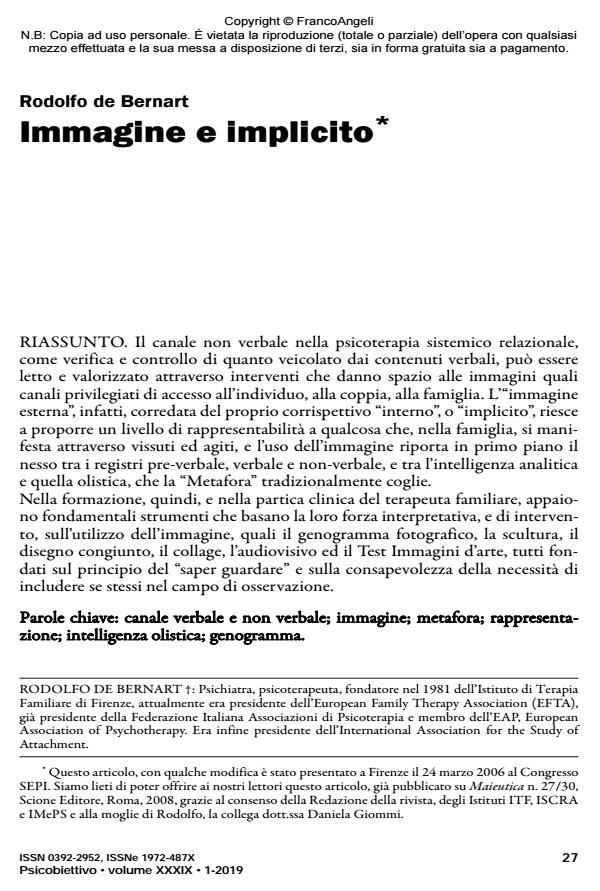Immagine e implicito
Titolo Rivista PSICOBIETTIVO
Autori/Curatori Rodolfo De Bernart
Anno di pubblicazione 2019 Fascicolo 2019/1
Lingua Italiano Numero pagine 14 P. 27-40 Dimensione file 130 KB
DOI 10.3280/PSOB2019-001004
Il DOI è il codice a barre della proprietà intellettuale: per saperne di più
clicca qui
Qui sotto puoi vedere in anteprima la prima pagina di questo articolo.
Se questo articolo ti interessa, lo puoi acquistare (e scaricare in formato pdf) seguendo le facili indicazioni per acquistare il download credit. Acquista Download Credits per scaricare questo Articolo in formato PDF

FrancoAngeli è membro della Publishers International Linking Association, Inc (PILA)associazione indipendente e non profit per facilitare (attraverso i servizi tecnologici implementati da CrossRef.org) l’accesso degli studiosi ai contenuti digitali nelle pubblicazioni professionali e scientifiche
Il canale non verbale nella psicoterapia sistemico relazionale, come verifica e controllo di quanto veicolato dai contenuti verbali, può essere letto e valorizzato attraverso interventi che danno spazio alle immagini quali canali privilegiati di accesso all’individuo, alla coppia, alla famiglia. L’"immagine esterna", infatti, corredata del proprio corrispettivo "interno", o "implicito", riesce a proporre un livello di rappresentabilità a qualcosa che, nella famiglia, si manifesta attraverso vissuti ed agiti, e l’uso dell’immagine riporta in primo piano il nesso tra i registri pre-verbale, verbale e non-verbale, e tra l’intelligenza analitica e quella olistica, che la "Metafora" tradizionalmente coglie. Nella formazione, quindi, e nella partica clinica del terapeuta familiare, appaiono fondamentali strumenti che basano la loro forza interpretativa, e di intervento, sull’utilizzo dell’immagine, quali il genogramma fotografico, la scultura, il disegno congiunto, il collage, l’audiovisivo ed il Test Immagini d’arte, tutti fondati sul principio del "saper guardare" e sulla consapevolezza della necessità di includere se stessi nel campo di osservazione.
Parole chiave:Canale verbale e non verbale; immagine; metafora; rappresentazione; intelligenza olistica; genogramma.
- Trame di luce Uso di immagini d'arte in terapia individuale e di coppia ad orientamento sistemico-relazionale Conny Leporatti, in PSICOBIETTIVO 1/2016 pp.137
DOI: 10.3280/PSOB2016-001010 - La luna e i falò. Uso di immagini d'arte in psicoterapia individuale e di coppia ad orientamento sistemico-relazionale Conny Leporatti, in TERAPIA FAMILIARE 111/2016 pp.51
DOI: 10.3280/TF2016-111004 - La supervisione aperta. Un modello evidence-based di supervisione Sabrina Tosi, in PSICOBIETTIVO 3/2024 pp.85
DOI: 10.3280/PSOB2023-003006
Rodolfo De Bernart, Immagine e implicito in "PSICOBIETTIVO" 1/2019, pp 27-40, DOI: 10.3280/PSOB2019-001004